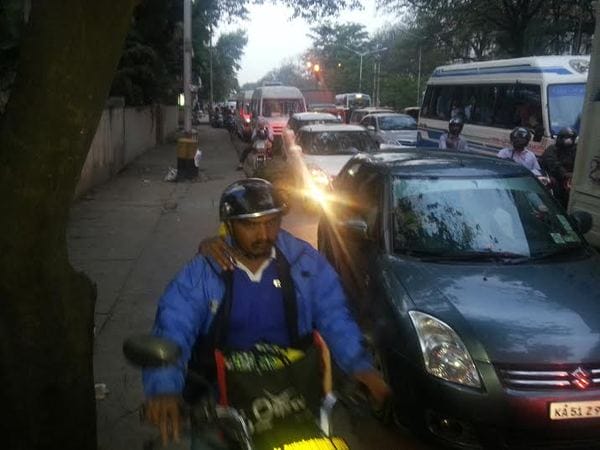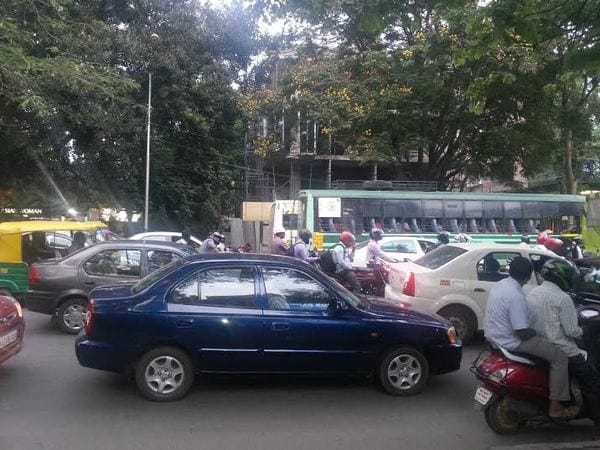
Continuous stream of traffic does not let people cross the road. Pic: Reji Thomas
The new one-way system introduced on the stretch from the Madivala Checkpost to Krupanidhi College, on Sarjapur Road has resulted in chaos and a terrible, unbearable traffic situation on this stretch. The residents in these localities woke up on April 26th morning and were shocked and surprised to experience that they could not come out of their houses and localities where they have been living for the last several decades. The one-way system introduced on April 26th, 2015 does not allow residents to take their cars and two-wheelers out of their houses as the volume and speed of traffic is so huge.
It is shocking and surprising how the decision-makers and the traffic police can take such unilateral decisions without consulting or considering the stakeholders in the area. The students of St Johns and the thousands of patients and relatives who come every day to St Johns Medical College and Hospital have been neglected as well.
Ironically, none of the decision-makers are the victims of these irrational decisions, and the ill-effects of their decisions are rudely thrust and enforced on the innocent and unfortunate residents.
Hosur Road needs intervention, not Sarjapur Road
The underpass that was once planned by the government was given up after much debate. Then, it was decided that Hosur Road should be the main road to take the load of the National Highway, as Sarjapur Road passes through a residential area splitting Koramangala 2nd block and 3rd block. The Ring Road through HSR layout was another option to meet this heavy traffic.
Now again, the residents on either side of the Sarjapur main road that splits Koramangala are facing the same problem. It is just not the traffic alone but also the quantum of sound and noise pollution caused by this diversion of traffic. Soot fills our houses, and the polluted air is bound to bring along an array of respiratory diseases and even cancer. The same holds good for the stretch in front of St Johns, which is supposed to be an NO-HORN area.
Will the Government and the Bengaluru Traffic Police assure the residents that the noise and pollution levels will be below the levels specified for healthy living? The area was declared residential when these layouts were formed. That was the reason many chose these areas for peaceful living decades ago. The sanity of a residential area must be maintained.

The one-way has restricted the movement of people in the area. Pic: Reji Thomas
Problems the one-way system has introduced
Access to hospital cut off: The new system disconnects St Johns Hospital from Koramangala, HSR and all localities on the Sarjapur Road. The lawmakers and administrators should have tried to make the access to one of the largest Multispeciality Hospitals in the country easy for people from every direction. The new system, unfortunately, seems determined to negate this aim.
The access to St Johns Hospital, both for emergency and routine patients would now take an additional 30-45 minutes. This affects the several thousands of staff and students who commute to St. Johns as well. It is a nightmare for doctors to reach St. Johns during emergencies. This fiasco was attempted a few years back and proved to be an utter failure and was hence abandoned. Why is it that the administration never learns from past mistakes in Bengaluru?
Pick up and drop of kids affected: Nursery and lower middle school students were hitherto being dropped and picked up from the SBI ATM near Kudremukh Colony. Now with this heavy and one-way traffic, how will they be able to do this? The small kids will now be dropped near Krupanidhi College, which is half-a-km away. How will they be able to cross the road at this junction? The starting point for school buses of Kendriya Vidyalaya was from the gate of the CPWD quarters where children from the Survey of India, Kuduremukh Colony and CPWD colony used to get in and were being dropped back. But, after the introduction of the new one-way system, it is impossible to stop the bus on the road and make the children get in. Many other school buses also face the same problem. To make things even worse, we have physically challenged children and residents whose only mode of transport has been eliminated as well.
Senior citizens are the most-affected: Majority of the residents in Kudremukh colony are senior citizens, who need access to necessities for day to day living. Over the past few days, several senior citizens are seen waiting for almost 30 minutes or more, before crossing the roads. Presently they can’t even cross the road to reach the post office, the Koramangala BDA Complex, etc. because of heavy, continuous and fast traffic. With the present one-way system, taxi and auto services are also not willing to pick up commuters from this area. Obviously we have been cut off completely from the city.
New bus stops wasted: Recently three new bus stops or shelters were constructed in between Water tank and Krupanidhi Junction. This served as the lifeline of the residents of Koramangala 2nd block and 3rd block. Thousands of employees and visitors of more than 45 Central government offices situated in Kendriya Sadan, Astro Physics and Survey of India buildings benefited from this. Just a few months back a concrete divider was put on the road in front of St Johns Medical College Hospital, and fresh bus stops were erected in the last few days using public money. Now there is no use for these structures.
Residential areas and offices of Koramangala 2nd Block have now become isolated islands to which there is no access. People in this area, irrespective of their age have to trek now through kilometers, cursing their plight, to avail a mode of public transport to move towards the city centre. The access to the nearby hospitals, shopping complexes, temples, churches, mosques, educational institutions and even to the market is denied to the residents of Koramangala making their lives miserable.
No pedestrian crossings: There are no pedestrian crossings, and even if there were, surely the eight-lane traffic does not respect this. Residents can’t get off an auto in front of their houses that are on the right side of the road. For, while trying to cross the road, they could be run over with the oncoming crazy traffic. The new system makes sure that students and other citizens who use public transport to the city will be totally disconnected, and have no access to public transport anymore.
While the world attempts to leave less of a carbon print on ecology, the new traffic system works against the basics of ecology. Thousands of vehicles that commute via the Sarjapur road every day have to take a much longer route, wasting precious fuel and time, causing pollution in a residential area. Probably the additional fuel burnt by this new venture, in a year, would be adequate to build a state of the art flyover on Hosur road, which would have been a perfect and ideal solution. Scientific data and surveys in the past have demonstrated that Hosur Road needs to be tackled and not Sarjapur road.
Democracy, negotiations, planning backed by on-site surveys and scientific data fosters development and surely not knee-jerk reactions of individuals. God save the residents who hope for better days ahead.
Related Articles
Bengaluru traffic police’s traffic plan in Madiwala: Will it work?
i have commuted on the route after the traffic diversion and found that the traffic situation is better and there is less stoppage time at traffic signals.Diversion had overall benefited people using the Hosur road and Sarjapur Road.
‘@nigin, less stoppage time at traffic signals is not a progressive indicator. All that it means is that pedestrians and public transport users have lesser time to cross roads. On the other hand, private vehicles are enjoying themselves whilst contributing to traffic congestion.
The article lays out the problems faced by this myopic traffic plan. Hope the authorities show some sense and take appropriate action.
Seems like the only way to educate people is to give them some pain! I can empathize with Dr. Thomas, but where was everyone when the police routed major traffic arteries through residential areas? As a victim of this type of ‘solution’, I expect that there will be no objections when others find themselves in the same situation.
I also find that while one can go through Cubbon ‘park’, I cannot cut across Lalbagh. Why not? What happened to the ‘activists’ when hundreds (thousands?) of trees were felled across the city? Why a lung space for those residing near Lalbagh only? It is unlikely that people from the other end of town will benefit from Lalbagh, we would much rather have a highway put through it.
While I’m on this topic, why does the road take a deviation near Raj Bhavan, I’d like a road through the Raj Bhavan, after all the politicians, who have no sympathy for others, have many houses and can shift outside Bangalore (preferably outside the country) if they find it too noisy and dangerous.
>> I also find that while one can go through Cubbon ‘park’, I cannot cut across Lalbagh. Why not? What happened to the ‘activists’ when hundreds (thousands?) of trees were felled across the city?
I can only assume you are being sarcastic.
If not, people have been asking for the roads inside Cubbon Park also to be closed for traffic.
I am not sure what bad or good it has done to the traffic, but quite amused the way it has been executed. No prior Intimation/information(as far as I know), suddenly you see some temporary hoardings(which can be dismantled easily by strong breeze!!!!!) which tells you not to take right, Only Go straight. Funny, its only possible in Bangalore and no doubt we have the worst traffic management here
I find very often that the educated citizenry of Bangalore is unable to transition into problem solving mode from their comfortable state of nostalgia for days long past. We need to understand that change happens – and has happened. We can build a better city, but we need to recognise that we have grown, and will continue to grow for a while.
We have immigrants. We have motor vehicles. We cannot and should not ban either.
It is all very well to say “Block traffic! People need to walk”, but plans such as these need to be implemented in harmony with economic activity. One cannot simply copy the models from low-population societies like Western Europe.
I don’t have solutions, but I know that the good Doctor doesn’t either. And this article is not helpful.